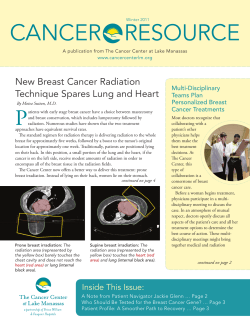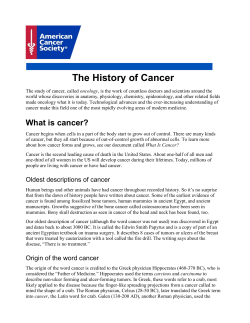
Inside the ACI
The Curtis and Elizabeth Anderson Cancer Institute at Memorial University Medical Center Inside the ACI Excellence in cancer care through research, education, and treatment. | Fall 2013 From the first abnormal test result, to the day you officially become a survivor, we’re with you every step of the way. Experience Excellence. Memorial Health. aci.memorialhealth.com Experience Excellence. Cancers that impact women By Guy Petruzzelli, M.D., Ph.D., MBA, FACS PHYSICIAN-IN-CHIEF, CURTIS AND ELIZABETH ANDERSON CANCER INSTITUTE This newsletter focuses on breast and gynecologic cancers that impact tens of thousands of women every year. But it’s important to note that cancer care for women includes much more than just breast and gynecologic malignancies. Of all new cancer cases diagnosed this year, it’s estimated that 48 percent of them will be in women. That means 805,500 of our mothers, wives, daughters, sisters, grandmothers, nieces, friends, and co-workers will receive a potentially life-altering diagnosis. The five most common cancers in women — breast, lung, colon and rectum, uterus, and thyroid — constitute 64 percent of all female cancer cases. Almost one-third (29 percent) of these women will be diagnosed with breast cancer, which will account for nearly 40,000 deaths (14 percent of all female cancer deaths) or a 17 percent mortality. Contrast this to pancreatic cancer that accounts for 3 percent of new cancers in women, but is responsible for 7 percent of female cancer deaths and a frightening 85 percent cancer mortality. Despite this serious prognosis, our team of skilled cancer surgeons is able to use the most sophisticated minimally invasive procedures to stage and remove pancreas tumors with reduced complications, allowing patients to start radiation or chemotherapy sooner. At the Curtis and Elizabeth Anderson Cancer Institute (ACI) at Memorial University Medical Center, teams of dedicated providers lead by highly skilled subspecialty surgeons treat women diagnosed with cancer. At the Center for Breast Care, women are evaluated and cared for by a team of professionals practicing in an environment designed exclusively for breast care. Our breast surgeons have at their disposal all state-of-the-art technology needed to provide 21st century care, from sentinel node biopsy to intraoperative radiation therapy. Our plastic surgeons are experienced in all forms of breast reconstruction and are skilled at creating natural results. Tumors of the uterus and ovary together account for 8 percent of new cancers in women. Our gynecologic oncology surgeons are fellowship trained and skilled in all contemporary treatments for female pelvic malignancies, including the da Vinci robotic surgical platform. As members of the Gynecologic Oncology Group, our gynecologic oncologists are able to access a national database of clinical trials designed to improve outcomes for these women. Lung cancer is the second most common malignancy in both men and women and accounts for 26 percent of all female cancer deaths. Historically, lung cancer has been diagnosed at advanced stages, resulting in 65 percent lung cancer mortality in women. Knowing that early detection results in the best chance for cure, we offer a lung screening program. Call 350-LUNG (5864) for more information. Finally, thyroid cancer is becoming one of the most commonly diagnosed cancers in women, accounting for 6 percent (45,310) of new cancer cases. Fortunately, the great majority of thyroid cancers are curable. Working with our partners in endocrinology, we have expanded our head and neck tumor program to include the diagnosis and treatment of all forms of thyroid cancer. We also perform office ultrasounds and ultrasound-guided needle biopsy of the thyroid at the time of office evaluation. We know that caring for women with cancer goes far beyond chemotherapy, radiation, and surgery. That is why we have invested in an integrative therapy program that includes therapeutic massage, acupuncture, mind-body medicine, yoga, music, and other complementary therapies to aid patients in their journey toward wellness. The dedicated professionals at the ACI are passionate about providing comprehensive, state-of-the-art care to all of our patients. The care of women with cancer is a particular privilege. Please feel free to contact me at any time with your thoughts regarding our cancer programs. I can be reached at guypetruzzelli@memorialhealth.com. 2 Accolades for cancer care Memorial University Medical Center (MUMC) was the highest-rated hospital in Savannah on U.S. News & World Report’s 2013-14 Best Hospitals list. The annual list, now in its 24th year, recognizes hospitals that excel in treating the most challenging patients. Memorial was also recognized for 10 high-performing specialties, one of which was cancer care. Earlier this year, the Curtis and Elizabeth Anderson Cancer Institute at MUMC received an Outstanding Achievement Award from The Commission on Cancer of the American College of Surgeons. It was the only facility in Savannah to receive the Outstanding Achievement Award and one of only three hospitals recognized in the state of Georgia. This is the third consecutive survey period in which the ACI has earned Outstanding Achievement. You can read more about these and other MUMC headlines at memorialhealth.com/current-press-releases.aspx. 3 New technology shortens breast cancer treatment time Sandy Jones of Hinesville had just started a brand new job when she discovered a lump in her breast. The 44year-old had completed her yearly mammogram just four months earlier, and everything looked fine. She was certain the lump in her right breast was nothing more than a cyst. Her gynecologist agreed that it was probably nothing, but requested another mammogram, just Sandy Jones to be safe. Jones was scheduled to travel for work on the day of her mammogram. She was anxious to get the procedure completed and get on the road. “I thought it would take 20 minutes and they’d be done. But I saw several people looking at my mammogram and discussing it. Then they told me I should have a biopsy,” said Jones. The biopsy toremove a sample of tissue was performed on a Wednesday. On Thursday, Jones learned that she had breast cancer. On Friday, she found herself sitting in the office of Ray Rudolph, M.D., MPH, a breast surgeon at the Center for Breast Care. Jones said it all happened so fast, she barely had time to think. Rudolph told Jones that she was a candidate for a new procedure called INTRABEAM intraoperative radiation therapy (IORT). The Curtis and Elizabeth Anderson Cancer Institute (ACI) at Memorial University Medical Center was the first cancer center in the state of Georgia to offer INTRABEAM IORT, and the technology had only been in Savannah for about six months. “We’re always looking for better ways to treat women with breast cancer. We want to find less invasive treatments that are just as effective,” said Rudolph. He and his colleague, radiation oncologist Aaron Pederson, M.D., were instrumental in bringing the technology to the ACI. With IORT, cancer-killing radiation is delivered in the operating room, at the time of the lumpectomy. After the cancer tumor is removed by the breast surgeon, a radiation 4 oncologist places a small applicator — 3 to 5 centimeters in diameter — into the tumor bed. Depending on the tumor size, the applicator is left in place for 13 to 43 minutes and delivers a dose of radiation directly into the tumor cavity. “The advantage of IORT is you can deliver the radiation exactly where you just took out the tumor. With breast cancer, most recurrence occurs within 1 centimeter of the original tumor. With IORT, the radiation is given right where you need it,” said Pederson. Jones learned that traditional treatment for her cancer would involve a lumpectomy followed by six-and-a-half weeks of daily whole breast radiation. But with IORT, she could reduce that to just three weeks of daily radiation. The IORT would serve as a “boost” and cut her radiation treatment time in half. For some women, IORT can even eliminate the need for any additional radiation after surgery. Whether IORT can serve as a boost or as the entire treatment depends on several factors, including the woman’s age, surgical margins, and tumor characteristics. “I tell my patients going into IORT, that you either win or you win big,” said Rudolph. Jones had surgery and IORT on March 25, 2013. Two weeks later, she was at the Susan G. Komen Race for the Cure in downtown Savannah. “IORT was absolutely the right choice for me. At the race, nobody could even tell I’d had surgery,” said Jones. In fact, some Race for the Cure participants had undergone surgery and IORT just two days prior, and they were able to attend the event. Jones especially appreciated IORT when she began her three weeks of daily whole-breast radiation treatments. She had to drive back and forth from her home in Hinesville to Savannah for treatment. Whole breast radiation can cause side effects such as fatigue and skin damage. But these effects are reduced when the treatment time is shortened. IORT helps many women avoid radiation side effects altogether. “We’re seeing that IORT has a better cosmetic outcome than traditional radiation. There is no dimpling, no swelling, none of the skin changes you might see with six weeks of whole breast radiation,” said Pederson. Rudolph and Pederson predict that IORT will eventually become the preferred standard of care for earlystage breast cancers. “This treatment creates less disruption and fewer side effects for patients. And it’s less expensive than other types of radiation. With IORT, we can provide an equally effective treatment for one-tenth of the cost and in one-thirtieth of the time” said Pederson. Just three months after being diagnosed with breast cancer, Sandy Jones was back at work full time and maintaining a heavy travel schedule. When asked how she feels about receiving IORT, her response is simple: “thankful.” Radiation treatment for women’s cancers By Aaron Pederson, M.D. RADIATION ONCOLOGIST The Curtis and Elizabeth Anderson Cancer Institute ACI at Memorial University Medical Center offers technology to safely deliver radiation with the highest level of accuracy and precision. During radiation treatment planning, the ACI captures fourdimensional scans of the breast. These detailed images guide radiation from many different angles and help to provide treatment to every part of the tumor. This technique allows us to radiate cancer cells while minimizing damage to the surrounding healthy tissue. The skilled team at the ACI delivers radiation with sub-millimeter accuracy, reducing treatment times and side effects for patients. The ACI also provides innovative radiation treatment for women with cancer of the cervix or uterus. simultaneous integrated boost intensity modulated radiation therapy (SIB IMRT) delivers very high, but targeted doses of radiation and shortens overall treatment times. SIB IMRT leads to better-thanexpected outcomes and less toxicity and side effects for the women receiving this treatment. To learn more about the extensive radiation oncology services at the Curtis and Elizabeth Anderson Cancer Institute at Memorial University Medical Center, visit memorialhealth.com/radiation-oncology-aci.aspx. To hear from Sandy Jones and other women who’ve received IORT for breast cancer, visit breastcancer.memorialhealth.com. You can watch videos from survivors, learn about the procedure, and even schedule a mammogram. 5 Seamstress won’t back down for ovarian cancer With her tape measure draped around her neck, Diana Smock is hard at work behind a sewing machine in her Wilmington Island alterations shop. Looking at her petite frame, warm smile, and spunky blonde haircut, you’d never guess that she is waging an all-out war against cancer. But Smock doesn’t want to be labeled a cancer patient. Instead, consider her a feisty business owner, a fighter, and an inspiration. When Smock was 58 years old, she noticed that her stomach was expanding. At first, she thought it might be a normal part of aging. But she also felt full all the time, even if she ate very little. Smock went to her doctor. She had a sonogram, followed by a CT scan. On July 8, 2010, Smock was told that she had stage IIIc ovarian cancer. Her gynecologic oncologist was James J. Burke II at the Curtis and Elizabeth Anderson Cancer Institute at Memorial University Medical Center. “I was sitting in Dr. Burke’s office [getting the diagnosis] and he said to me, ‘you can cry.’ But I didn’t. I said, ‘let’s operate,’” said Smock. Diana Smock She underwent an intricate surgery to remove her uterus, her ovaries, and tissue from her colon, bowel, and stomach. Burke also drained two liters of fluid from Smock’s abdomen. The fluid had built up around the tumor and was causing the full, bloated feeling. Smock spent 10 days at Memorial University Medical Center, and another two weeks recovering at home. But after that, she was ready to get back to her shop. “I needed to go to work and stay busy. It doesn’t do any good to sit around the house and think about having cancer. I need to keep living. I’m not dead yet!” said Smock. At Burke’s recommendation, Smock enrolled in a clinical research trial to test a new chemotherapy treatment for ovarian cancer. When Burke gave her information about the possible side effects of the treatment, Smock didn’t read it. “I didn’t want to know the side effects or the statistics. Sometimes, the more you learn about it, the more scared you get. I never thought about dying. I thought about fighting,” said Smock. And so began a year-long rigorous chemotherapy regimen. When she felt sick, she took an anti-nausea pill and went to work. When she felt tired, she drank a cup of coffee and kept going. When she lost her hair, she bought wigs to wear. Throughout everything, Smock kept her shop open and kept her attitude positive. By the time her 60th birthday arrived, her treatment was complete. Smock’s friend, inspired by her amazing strength and determination, hosted a black-tie birthday celebration to raise funds for ovarian cancer programs. Together, they raised $52,000 for the Curtis and Elizabeth Anderson Cancer Institute. Smock continued to work and kept her spirits up. About 10 months ago, during a follow-up visit, Burke discovered another cancerous spot on Smock’s pelvis. Once again, she qualified for a clinical trial. She became the first woman in Savannah to test the effects of a drug called pazopanib for advanced ovarian cancer. She takes three pills a day and receives low-dose chemotherapy three times a month. Smock says the treatment regimen is working because the spot on her pelvis has not spread in almost a year. She is optimistic about her future. “I could be on this current clinical trial long enough that they finally find a cure for my cancer,” said Smock. Her mantra is stay busy and don’t give up. If there is work to be done or fun to be had, Diana Smock will take care of it. She is determined to live her life on her terms, and cancer won’t get in her way. For more information about the clinical trials available at the Curtis and Elizabeth Anderson Cancer Institute at Memorial University Medical Center, visit memorialhealth.com/clinical-trials.aspx or call 800-343-3025. If you’d like to contribute to a fund to benefit ovarian cancer patients at Memorial Health, contact the Memorial Health Foundation at 912-350-6370. 6 A cut above: New technology for women’s cancer surgeries Surgery – the act of physically removing cancer cells from the body — is the oldest form of cancer treatment. Modern surgical technology has moved many procedures to an outpatient setting, meaning patients go home the same day, often with only tiny scars and minimal, easily controlled pain. The Curtis and Elizabeth Anderson Cancer Institute (ACI) at Memorial University Medical Center has a team of highly skilled surgical oncologists who specialize in all aspects of cancer surgery, including breast and gynecologic procedures. The ACI recently added even more technology to further expand women’s surgical options. da Vinci robotic surgery For complex gynecologic procedures, surgeons James J. Burke II and Scott Purinton use the da Vinci Si Surgical System. This is often referred to as “robotic surgery,” although every procedure is done by actual surgeons. The da Vinci uses a state-of-the-art program that mimics the surgeon’s hand movements through tiny instruments within the body. This enables the surgeon to perform even the most complex and delicate procedures through very small incisions – often no bigger than 2 centimeters. For the patient, benefits of robotic surgery include less pain, less blood loss, smaller scars, less risk of infection, and a shorter hospital stay. ‘SPY’ technology Memorial University Medical Center was the first in Savannah to offer state-of-the-art “SPY” technology for breast reconstruction surgery. When women undergo breast reconstruction after a mastectomy, surgeons may create a new breast from the woman’s own abdominal tissue. This involves moving a flap of tissue from the abdomen to the breast, and reattaching tiny blood vessels. If blood does not flow correctly through the vessels, the tissue can die and more surgery is needed. With SPY technology, surgeons inject a safe fluorescent dye into the body. A laser within the SPY system follows the dye and sends the surgeon highquality video images of blood flow within vessels, micro-vessels, tissue, and organs. The images appear within minutes and in real-time. This allows surgeons to ensure a healthy blood flow to the breast mound and precisely reattach blood vessels and the breast skin flaps. These new advances make surgery safer and less traumatic for patients. Today, many women recover quickly and are able to get back to their normal lives within a few weeks. 7 Get by with a little help from your friends Helen Keller once said, “Walking with a friend in the dark is better than walking alone in the light.” Those words become especially poignant after a cancer diagnosis. When facing a life-threatening disease, people need friendship and support to pull them through. There’s something very healing about knowing you are not alone. “No two people will face cancer the same way. Different people need different types of support. Our goal is to help them find what they need to cope with their treatment and transition from cancer patient to cancer survivor,” said Jennifer Currin-McCulloch, LMSW, OSW-C, manager of oncology support services at the ACI. The support services at the Curtis and Elizabeth Anderson Cancer Institute (ACI) at Memorial University Medical Center strive to offer physical, emotional, and spiritual support for people with cancer. Some of the ACI’s support services are listed here. To find out more information about the support programs at the ACI visit memorialhealth.com/aci-support-services.aspx, or call Jennifer Currin-McCulloch at 912-350-7845. “The first thing we do is acknowledge the fear that a newly diagnosed patient can have. Cancer is something that comes into their life that they didn’t invite. It’s like a rude houseguest that comes in and takes over your living room,” said Jennifer Sili, R.N., the breast cancer nurse navigator at the ACI. Community support groups are available for children, caregivers, people in treatment, and cancer survivors. The groups meet monthly or quarterly to share advice, hear guest speakers, and offer support to one another. Nurse navigators help guide patients through the treatment process. They also connect patients to support services – everything from traditional support groups to financial assistance programs. 8 Survivorship Lecture Series addresses physical, social, psychological, and spiritual health after treatment. This lecture series helps create building blocks for healthy survivorship and long-term healing. Integrative Therapy Services Integrative therapy combines traditional medical therapies with alternative therapies that have been proven to provide a health benefit. Integrative therapies can assist patients in coping with anxiety, stress, and treatment-related side effects. • • Acupuncture and reflexology are ancient treatments that may help ease stress and pain. Acupuncture involves stimulating pressure points with small needles. This service is available to ACI patients through a partnership with Bauer Coslick of Vitality Acupuncture. Reflexology applies gentle pressure to specific points on the feet, hands, ears, or face. Both treatments help relieve nausea as well as pain and stress. Art therapy includes journaling, decorating memory boxes, designing scarves, and various other therapeutic art projects. This program is offered through a partnership with the Savannah College of Art and Design and the Healing and Education through Art initiative. Activities are offered at the patient bedside or in group settings. • Massage therapy is offered twice a week for people receiving inpatient or outpatient cancer care. A licensed massage therapist provides gentle touch treatment to promote wellness and relaxation. • Music therapy is offered several times a week. The ACI partners with Savannah Philharmonic musicians to provide live performances in the ACI lobby and on the inpatient oncology floor. • Pet therapy is provided by certified pet therapy dogs that visit the ACI twice a month. They offer plenty of hugs, kisses, and unconditional love for people with cancer and their families. Physical Wellness Programs These support services focus on helping people build their strength and endurance to get through the rigors of cancer treatment. These programs also benefit survivors after treatment. • Strength for Survivors is a program that enables cancer survivors to meet with a personal trainer who guides them through the recovery and healing process. The program includes massage, yoga, Pilates, strength training, cardiovascular conditioning, and stretching exercises. • Yoga classes are offered free of charge for cancer survivors and people receiving treatment. The classes help with flexibility, balance, and relaxation. The instructor received specialized training at OM Yoga Center in New York. • Nutritional counseling is offered by a licensed dietitian. Participants learn how a balanced diet can help them get through treatment, maintain their energy, and lower their risk of recurrence. • Pain management and palliative care services are offered to help patients manage their symptoms and improve their quality of life during treatment. We offer inpatient and outpatient assessments for issues such as pain, nausea, fatigue, depression, anxiety, sleeplessness, and other treatment-related side effects. The services are offered through a partnership with the Steward Center for Palliative Care. A cancer diagnosis might make you feel like you’re walking in the dark. But you’re not alone. We encourage you to take advantage of the services that can help you through this difficult time. Again, for a full list of support programs, visit memorialhealth.com/aci-support-services.aspx, or call to 800-343-3025. 9 Five things every woman should know about gynecologic cancers By James J. Burke II, M.D., GYNECOLOGIC ONCOLOGIST and Scott Purinton, M.D., Ph.D., GYNECOLOGIC ONCOLOGIST Gynecologic cancers occur in the female reproductive organs and pelvic area. There are several types: • • • • • • • • 10 Cervical cancer — begins in the lower part of the uterus that opens into the vagina. Endometrial/uterine cancer — begins in the uterus or the lining of the uterus, which is called the endometrium. This is the most common gynecological cancer. Fallopian tube cancer— forms in the fallopian tubes. Gestational trophoblastic disease — cancer associated with a normal or abnormal pregnancy that affects the placenta. Ovarian cancer — forms in the ovaries. Primary peritoneal cancer — affects the tissue that lines the abdominal and pelvic cavities. Vaginal cancer — starts in the tissue of the vagina. Vulvar cancer — begins in the folds of skin that cover the vagina (the labia). One of the biggest challenges with gynecologic cancers is the fact that many of them are not discovered until they have reached an advanced stage. A Pap smear may detect abnormal cells before they transform into cervical cancer, but there are no effective early screening tests for other gynecologic cancers. That’s why it’s vitally important for women to pay attention to their bodies, recognize warning signs, and talk to their doctors. Here are five things every woman should know about gynecologic cancers. 1. Know the early warning signs. Often, your body will tell you when something is not right. The early signs of a gynecologic cancer can be subtle, but they should never be ignored. Early symptoms include: • • • • • Abnormal bleeding, such as bleeding between periods, bleeding after menopause, or unusually heavy bleeding. Changes in bathroom habits, such as painful urination, diarrhea, or constipation. Unusual vaginal discharge. Pain during intercourse. Pain, pressure, or a mass in the lower abdomen, or feeling bloated or full in the lower abdomen. • • • Burning, itching, or pain in the genital area. Skin changes on the vulva. Fatigue, unexplained weight loss, or other sensations that just don’t feel right. If an unusual symptom lasts at least two weeks, talk to your doctor. Do not assume the problem is normal or will go away on its own. ovarian and uterine cancer, but slightly raise the risk of cervical cancer. Taking estrogen without progesterone during menopause can increase the risk for gynecologic cancers. In addition, women who take tamoxifen to prevent breast cancer recurrence have a slightly increased risk of developing uterine cancer. Before using any synthetic hormones, discuss all of the pros and cons with your doctor. 4. Consider the HPV vaccine and HPV testing. 2. Get serious about your own health. Too often, women put their own health needs last on their to-do list. But living a healthy lifestyle can lower your risk for every type of cancer, including gynecologic cancers. • • • Maintain a healthy weight. Research has shown that obesity is linked to gynecologic cancers. There is an enzyme in fatty tissue that converts androgen hormones into estrogens. Unopposed estrogen causes endometrial cancer. When you maintain a healthy weight through exercise and a low-fat diet, you significantly lower your cancer risk. Stop smoking. We know for a fact that smoking releases cancer-causing carcinogens into the body. It is hard to quit smoking, but the health benefits are worth it. Ask your doctor for help. Have regular check-ups. A Pap test and pelvic exam should be part of every woman’s routine healthcare, from age 21 through 65. Some gynecologists only require a Pap test every two or three years in women who have had a series of normal test results and who do not have any strong risk factors for a gynecologic cancer. But a pelvic exam should be scheduled annually. Your gynecologist can help you determine the schedule that is best for you. 3. Understand the effects of hormones. Synthetic hormones taken in the form of birth control pills or hormone replacement therapy can impact your gynecologic cancer risk. Using birth control pills for five or more years has been shown to lower a woman’s risk of Human papillomavirus (HPV) is the most common sexually transmitted virus. It is linked to cervical, vaginal, and vulvar cancer. • • Pediatricians now offer an HPV vaccine for girls and boys. It is a series of three injections that protects against cervical, vulvar, and vaginal cancers and precancers, as well as anal cancers and genital warts. The vaccine is typically given at age 11, but girls may receive the vaccine as young as age 9 or as old as age 26. Women age 30 and over can ask for an HPV test with their routine Pap test. An HPV test is typically ordered when there is an abnormal Pap test. However, you can ask your gynecologist to do the test regardless of your Pap results. If you have HPV, your doctor may recommend further testing. Being diagnosed with an HPV infection does not mean you will get a gynecologic cancer. But it does mean you are at an increased risk and should be vigilant about screening and watching for early warning signs. 5. If you are diagnosed with a gynecologic cancer, seek the expertise of a fellowshiptrained gynecologic oncologist. These doctors have received three additional years of specialized training in the field of gynecologic cancers, in addition to four years of medical school and four years of residency training. Fellowship-trained gynecologic oncologists such as Burke and Purinton are familiar with the latest treatment techniques and clinical trials that may benefit you. The Curtis and Elizabeth Anderson Cancer Institute at Memorial University Medical Center was the first facility in southeast Georgia to provide fellowship-trained gynecologic oncologists to treat gynecologic cancers. They are also skilled in robotic surgery for complex gynecologic cancers. To learn more about our program, call 800-343-3025 or visit memorialhealth.com/gynecologic-oncology.aspx. 11 NON-PROFIT U . S . P O S TA G E 4700 WATERS AVENUE SAVANNAH, GEORGIA 31404 PAID SAVANNAH, GA PE R MIT N O. 8 0 Your gift makes a difference The Memorial Health Foundation is a nonprofit organization authorized to receive gifts for Memorial University Medical Center (MUMC) The Foundation strives to ensure that MUMC has the resources necessary to provide world-class healthcare services for the community. Gifts to the Foundation help pay for leading-edge technology, such as the INTRABEAM intraoperative radiation therapy equipment. Gifts to the Foundation’s patient assistance funds help improve the quality of life for people with cancer. These programs provide fuel cards to ensure that patients can get to their follow-up appointments. They help pay for anti-nausea medicines, acupuncture, and massage therapy to help patients cope with the side effects of treatment. These funds also provide counseling, mammograms for women in need, and genetic testing assistance. All of these resources are important to the care of cancer patients and their quality of life. Most of these services would not be available without the generosity of our donors. To learn how you can help, please contact Anne Cordeiro at the Memorial Health Foundation at 912-350-8934 or Cordean1@memorialhealth.com.
© Copyright 2025















